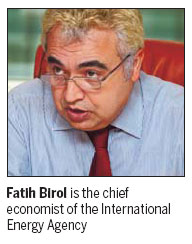China a leader in renewable energy
Updated: 2011-12-10 08:06
By Zhang Chunyan (China Daily)
|
|||||||||

LONDON - China last year became the largest global investor in renewable energy and is now a leader in the industry, the chief economist of the International Energy Agency said.
Every step that China takes to limit emissions growth is closely examined as China has been a big emitter of greenhouse gases, Dr Fatih Birol told China Daily in an exclusive interview.
"(China's) per capita emissions are still low, however, compared to most advanced economies," Birol added.
Birol is tasked with overseeing the World Energy Outlook reports, the Energy Business Council and the organization's economic analyses of energy and climate change policy.
"Our analysis shows a gap in what global reductions should really be. More should be done, by developed and developing economies alike, respecting the principle of differentiated responsibility," he said.
In 2009, China voluntarily set a target of reducing power consumed per unit of economic output - a measure known as "energy intensity" - by 40 to 45 percent by 2020, compared with 2005 levels, while also increasing the share of energy produced by renewable sources to 15 percent and expanding forest cover.
According to a white paper on China's climate change, 1,560 Chinese projects have been registered with the United Nations Clean Development Mechanism Executive Board, accounting for 45.67 percent of the world's total registered programs.
The estimated certified emission reduction (CER) of these projects has reached an annual issuance volume of 328 million tons of carbon dioxide, accounting for 63.8 percent of the world's total and providing valuable support for the implementation of the Kyoto Protocol, the white paper said.
The negotiations at the United Nations Climate Summit in Durban, South Africa, have become increasingly tense over the past 10 days with protesters thrown out of the proceedings.
The Kyoto Protocol, the only climate change treaty in the world that commits most rich countries except the US to cutting emissions, ends at the end of 2012.
"Our latest analysis published in the World Energy Outlook 2011 shows that as far as the energy sector is concerned, existing infrastructure (including power plants, industries and buildings) will take up 80 percent of permissible emissions and have a 50 percent probability of limiting a long-term temperature increase to 2 C," Birol said.
If an internationally coordinated action is delayed until 2017, all new infrastructure built afterward will have to be zero carbon, which will be costly and difficult to achieve in practical politics, Birol said.
The door is closing to achieve the 2 C goal the UNFCCC member countries signed in Cancun, Birol said, adding that "baby steps are being taken by negotiations, while really what we would need in Durban is a heroic leap".
Reaching an agreement on the Green Climate Fund is considered one of the critical targets of the Durban conference.
The fund, agreed on at the UN climate talks in Cancun in 2010, aims to raise and distribute $100 billion per year by 2020 to help developing and vulnerable nations tackle the effects of climate change.
"This is a crucial point where in Durban we could see a step ahead. Of course at the moment when the money will have to be paid, we will have to see whether this money will be available and forthcoming from Western countries' governments," Birol added.
China Daily











